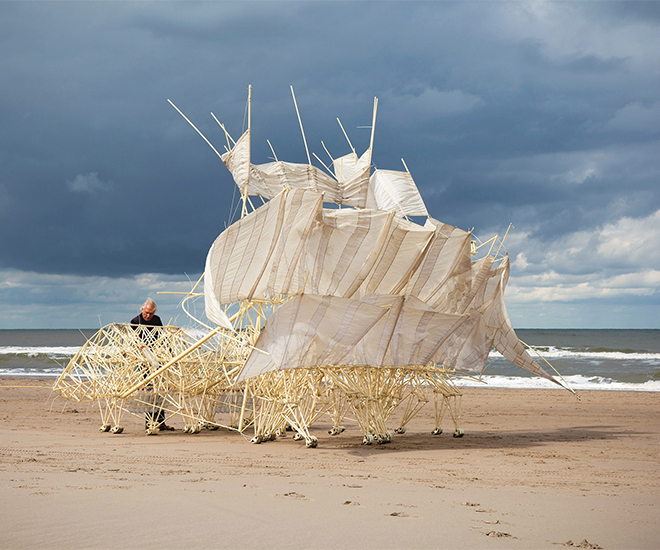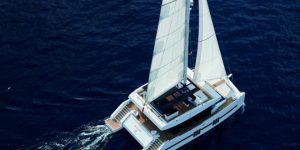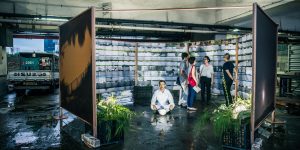Theo Jansen’s famed Strandbeests in Singapore thanks to Audemars Piguet
Theo Jansen’s famed Strandbeests in Singapore thanks to Audemars Piguet. Rare is the sponsorship which so accurately conveys the majesty of science and art – gearwork in fantastic, sculpturally intelligent form

There are many brand sponsorships which pan out to be philosophically head-scratching or literally brand incompatible, but every once in a while, an amazing, groundbreaking work of art is sponsored that shares so much in common with their sponsor that new perspectives of the brand result – case in point: Theo Jansen’s famed Strandbeests, his first Southeast Asian exhibition, now showing at the ArtScience Museum at Marina Bay Sands Singapore.
Fantastic Beests and Where to Find them: Singapore ArtScience Museum
Sponsored by Audemars Piguet, Theo Jansen’s 13 large-scale “beasts”, each with their own unique characteristics have made their way to Singapore’s ArtScience Museum. Jansen’s Strandbeests are a globally acclaimed collection of moving sculptures intricately constructed by everyday objects. These wind-walking beasts take their name from the ingenious set up of turning pivot points and wind activated pneumatic pumps which then provide impulse to the moving “ski-pole” limbs of the Strandbeests in a performance of art and science.

Jansen walks in the footsteps of legendary physicist-artist Leonardo da Vinci, applying scientific principles to a method of madness to create artistic works of self-propelled Strandbeests, utilising nothing but wind power to walk in extraordinary lifelike fashion. What makes this all possible is Jansen’s neural system.
Jansen’s neural system is what a mainspring is to the escapement assortment of a watch. Wings, driven by wind, fill a series of soda bottles with pressure, this pressure is slowly released to pistons which than drive the rest of the levers to provide motion to his Strandbeests. Also, similar to the mainspring, the pressurised bottles also allow Theo Jansen’s famed beach animals (Strandbeests in Dutch) independent motive power (for a period) even when the wind dies down. In essence, it’s a muscle, with the pistons and tubes becoming longer or shorter depending on the valve or “nerve”. The valves are themselves driven by a series of smaller “nerves” – in essence, functioning as simple (aka binary) brains for the beests.


One supposes that our fascination with Da Vinci’s fantastic machines and today, with timepieces like the Royal Oak Double Balance wheel openworked is derived from child-like amusement in the wonders of seemingly alive, independent automatons. In this respect, the perception of luxury watchmaking isn’t simply just about the decorative and artistic value of the handicrafts involved but also, a return to that time when joys were simpler and much easily derived from amusement with just the natural wonders and physics of the universe. But I digress.
“There are few people working today who embody the intersection of art and science as beautifully as Theo Jansen. For nearly 30 years, he has combined his understanding of science, with his artistic skill, to engineer mechanicals animals that appear startlingly alive.” – Honor Harger, Executive Director of ArtScience Museum
Originally designed to combat rising sea levels by roaming the beaches, powered by wind, and then pushing and piling sand on the shore to form protective dunes on the beachhead, the Strandbeests have enjoyed over two decades of experimentation and evolution: so smart are Theo Jansen’s Strandbeests that they are able to adapt to changing environmental conditions, navigating the shore through changing tide direction and anchoring themselves against oncoming storms – key survival features for these delicate beasts.

Presenting – Wind Walkers: Theo Jansen’s Strandbeests
The Wind Walkers exhibit at ArtScience Museum, a first for Theo Jansen’s Strandbeests in Southeast Asia, is an invitation for visitors to get up close with these larger-than-life creatures, driven by everyday items, and experiencing their extraordinary naturalistic movement first hand.
Presented in four sections, Wind Walkers: Theo Jansen’s Strandbeests charts Jansen’s vision from origin to conception while showcasing the science and physics behind the locomotive process of the beasts. It’s a showcase of 13 Strandbeests in Singapore and the films, sketches and prototypes which shed light on how this visionary artist creates these wonders.
Wind Walkers at Singapore Art Museum is an interactive educational activity for all-ages that explore physics, engineering and art. Exhibition opens 23 June 2018. $19 for Adult, $16 for Singapore residents. Seniors enjoy discounted rates of $14 and $12 respectively. Family packages are available for 2 adults and 2 kids at $54 and $45.

Strandbeests in Singapore thanks to Audemars Piguet
Audemars Piguet has always sought to integrate creative vision with superb artistry and technical mastery. The brand has supported Art Basel since 2013 and supported annual projects that give artists the freedom to create works that offer their own, highly personal interpretation of the company’s cultural and geographical origins, emblematic of the brand’s most deeply held values. Audemars Piguet first co-presented Theo Jansen’s Strandbeests at Art Basel 2014 on Miami Beach.









